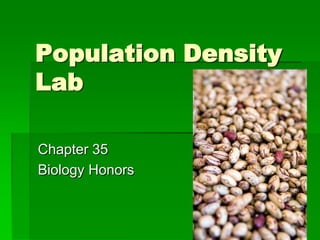
Population density lab
- 1. Population Density Lab Chapter 35 Biology Honors
- 2. Instructions AT the end of the presentation… Get into Groups of 3 Bring up a paper with your group members names to receive your field equipment Pick a material person This person must make sure the bag is returned in its original condition to the instructor at 9:15 am
- 3. Background You and your fellow ecologists have discovered a rare spotted beanie population along the outskirts of Hialeah Gardens High School in the melaleucawoodland. The woodland covers an area 3.5 km by 7 km. The beanies are small and very quick during the day and become sessile creatures (burrow in the ground and do not move) at night. They like their space, so at night, their burrows are evenly distributed (they don’t like to clump together.
- 4. Purpose To use the mark-recapture and quadrant sampling techniques to determine the population of the rare spotted beanie species Determine the population density of the Beanie population in the woodland (using both methods of population estimation) To report your findings to the National Spotted Beanie Association so they can update their ecology journals
- 5. Materials In each brown paper bag there should be: One permanent marker (if it is yellow, bring it up front later to exchange for a darker color) One ruler A ziploc baggie with the unknown population of rare spotted beanies A cup A sheet of aluminum foil (this will be handed to groups of three)
- 6. Procedures Based on what you have learned about the various techniques used to estimate populations, you will develop your own method for quadrant sampling and the mark-recapture method. Here are some pointers: Aluminum sheet is to be used for the quadrant sampling Fold up edges to make the aluminum sheet like a shallow pan so the beanies won’t escape Use permenent marker and ruler to make quadrants Brown paper bag is to represent the ecosystem of the rare spotted beanies for the mark-recapture method Use permanent marker to make a distinguishable mark on your organism for the first capture Use the cup to capture beanies fromtheir ecosystem
- 7. Calculations Here is a refresher: Population density= (individuals/unit area) Quadrant sampling involves counting number of species in each quadrant then repeating with several quadrants and then average your results to get avg. total population More quadrants= more accurate You do NOT want to count every quadrant, that is unrealistic Total Population=(# in 1st capture x # in 2nd capture)# of marked individuals in second capture Remember, in research, you need to have at least three trials for each method
- 8. Write-Up Purpose Background (at least one page, double spaced on background of population ecology, methods of calculating population, and info from this lab) Hypothesis (more than 1) Materials and Procedures (VERY specific…for quadrant sampling and for mark-recapture) Data/results/calculations Calculations (Show ALL work and UNITS!!!!) Quadrant sampling 3 trials Scale 1cm=?m (or km) Area of each quadrant= length (in m) x width (in m) Total number of quadrants Average population for EACH trial (# of beanies in chosen quadrants/# of quadrants) Population density for each trial (total individuals in trial/total area of ecosystem in meters) Mark-Recapture 3 trials Total population from each trial Procedure for determining population density for each trial ( with markings/tags used for each trial) Population density for each mark-recapture trial (total individuals in trial/total area of ecosystem in meters) Results (Tables for each method and trial) (Totals for each method and trial…optional: graphs) Conclusion (One to two pages…12 pt font, times new roman font, double spaced…worth the most) Analyze your result. Explain how you got you final population number. Describe limits to accuracy, problems you may have encountered, how this simulation is different from what would actually occur in nature. What method do you think was most accurate? Why? How could this have been improved? What if the beanies were never sessile? Predict what would happen to the population if their habitat (the melaleuca woodland) was destroyed? Include any other relevant information. This section should be very thorough (hint a page or two)
- 9. Follow Lab Report Guide Lines on Blog for the Typed Lab Report you are turning in
- 10. Turning in at the end of class… Rough draft of your write-up Everyone in the group MUST turn in their own paper Formal Report TBA
